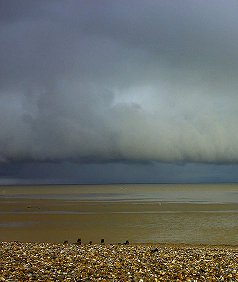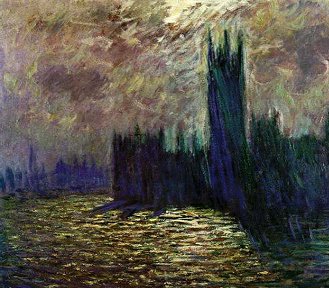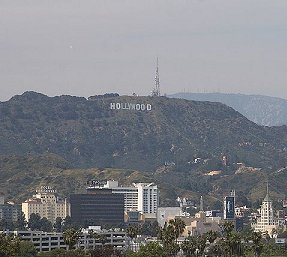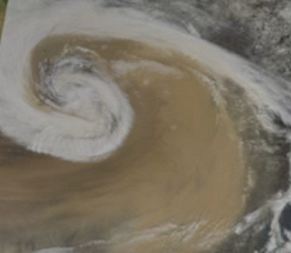This page is part of a series on insolation-factors.
An overview is provided at insolation.
The pages are:
sun angle,
air mass,
day length, and
clouds and pollution.

Both clouds and pollution scatter and absorb solar radiation and reduce the amount of insolation the falls on the ground below.
This page looks at how different amounts of clouds and pollution impact sunlight's strength.
One of the biggest determinants of the amount of solar radiation that reaches an area is cloud coverage.
If the sun is shining directly overhead in a cloudless sky, we receive around 1000 W/m2 of sunlight on the earth's surface. With light cloud cover, some of the light is absorbed and scattered by the clouds and more of the light that comes through is diffuse (scattered, not direct) and the earth's surface might have to make due with something like 830 W/m2.
Medium cloud coverage could reduce total irradiance down
to 300 W/m2 and low-hanging clouds could bring it down
to
230 W/m2. If it is really really overcast, you might end
up with less than 150 W/m2 in the middle of the day.1
Many of the factors that impact insolation can be precisely forecast on a day-to-day basis. Cloud coverage cannot be. Though general trends in cloudiness can be known, Clouds are capricious and on any given day will come and go as they please.
In the first part of this section, we look at air pollution in the developed world and conclude that it isn't having a huge impact on insolation levels. After that we discuss the atmospheric brown clouds that are greatly reducing the amount of solar radiation falling in many cities in more recently industrialized nations.

The kind of smog that is most prevalent in the US and other industrialized nations is photochemical smog. It is composed almost entirely of ozone (O3 - three oxygen atoms bonded together) which is made when pollutants from cars and factories mix with sunlight and high temperatures (above 70F/21C).
Tighter emissions standards have greatly reduced this sort of smog in richer countries.
For example, in Southern California, the number of first-stage ozone alerts (declared when the ozone concentration is greater than .20 ppm; "ppm" stands for "parts per million") called per year in the late 1970's was about 120; by the end of the 1990's, they were having around 6 first-stage ozone alerts a year.
They didn't have any first-stage ozone alerts from 1998 to 2003 (they had one in 2003). There hasn't been a second-stage ozone alert (ozone concentration at least .35 ppm) in the area since 1988.2
In 1981 researchers measured solar radiation levels during a second-stage ozone alert (ozone at least .35 ppm) in Alhambra, California. At noon the direct insolation was reduced by 40% and the total global insolation was reduced by 15%.3
On a clear day when the sun is high in the sky, the direct insolation is generally close to 85 or 90% of the total insolation and the diffuse insolation is close to 10 or 15%. [The final part of insolation - reflected insolation - only makes up a significant part of the total insolation in special conditions like when there is snow on the ground (see types of radiation for more).]

Putting all this information together, we can see that when the ozone concentration is around .35 ppm, not only does the total radiation level drop by 15%, the ratio of direct to diffuse light also changes:
Instead of being about 85% direct and 15% diffuse like it is when the sun is high in the sky on a clear day, on a very smoggy day the insolation is more like 60% direct and 40% diffuse.
Or, you could look at it this way: of the 40% of direct radiation lost due to heavy smog, over 55% of it is replaced with diffuse radiation. [To see the math: 4.]
Photovoltaic and solar hot water systems can make some use of diffuse radiation but concentrated solar power plants can't. CSP is usually not in urban areas anyway but it is of course true that sometimes urban spreads and effects rural areas.
Since current ozone levels in developed nations tends to be considerably less than the levels experienced in this 1981 study of a second stage photochemical smog alert, it seems likely that pollution doesn't have too huge of an impact on insolation in these countries.
Indeed, according to a book on pollution written in 2006, air pollution generally reduces direct radiation in urban areas by 10 to 20%.5
Assuming (note: as of yet I have not been able to verify this assumption) that the pollution also replaces the lost direct radiation with new diffuse radiation in a manner similar to the one discovered in the 1981 study, the total insolation in a polluted area would be more than 90 to 95% of the total insolation in an unpolluted one. [To see the math: 6.]

Currently, pollution does not appear to be too dramatically altering insolation levels over urban areas in the most developed nations.
However, there is a phenomena known as atmospheric brown clouds that is currently very pronounced in parts of China, India, Southeast Asia and South Africa.
These brown clouds are described in a United Nations Environment Programme (UNEP) report as "...regional scale plumes of air pollution that consist of copious amounts of tiny particles of soot, sulphates, nitrates, fly ash and many other pollutants."7
The clouds can greatly reduce the amount of solar radiation that falls on the lands beneath them.
The surfaces of India and China are now at least 6% dimmer than they were before the beginning of industrialization. Some of the cities most affected by brown clouds are receiving between 10 and 25% less solar energy than they used to.
A loss of 25% of your total solar radiation is very significant. Air mass only reduces the radiation by 25% when the sun is less than 25° degrees above the horizon.8
[Some of the most effected brown clouded cities are: : Bangkok (Thailand), Beijing (China), Cairo (Egypt), Dhaka (Bangladesh), Karachi (Pakistan), Kolkata (formerly Calcutta; in India), Lagos (Nigeria), Mumbai (formerly Bombay; in India), New Delhi (India), Seoul (South Korea), Shanghai (China), Shenzhen (China) and Tehran (Iran).] 9
If this page has been a help to you
please recommend it with Google+ below:
1. The SAO/NASA Astrophysics Data System has an article on
Clouds and Sunlight that I used for most of the facts in this section. In particular:
"For overcast conditions, median transmittance percentages with respect to the clearsky
situation of 81%, 44% and 36% at high, medium and low clouds respectively for erythemal irradiance,
and 83%, 30% and 23% for total irradiance were determined, similar to results at mid-latitudes of
the Northern Hemisphere." I then multiplied the percent of total irradiance in the cloud conditions
as compared to clear-sky conditions by 1000 W/m
2. All of the information about Southern California's ozone levels is from "Southern California Environmental Report Cards" done by UCLA's Institute of Environment and Sustainability. The reports are housed here: SoCal Environment Report Cards. All the facts except the one about the 2003 stage-1 ozone alert were from page 7 of the 1998 report card. The 2003 fact was from page 22 of the 2003 report card.
3. This data was from a paper entitlted "Urban air pollution and solar energy." It was published in International Journal of Ambient Energy, vol. 2, Oct. 1981, p. 183-195. The authors were Gammon, R. B.; Huning, J. R.; Reid, M. S.; Smith, J. H. It is housed here: Urban air pollution and solar energy.
4. First we demonstrate this statement: "on a very smoggy day the insolation is more like 60% direct and 40% diffuse." Normally, direct radiation is about 85% of the total typical solar radiation (when the sun is high in the sky on a clear day). If pollution lowers direct radiation by 40%, the amount of direct radiation in the sky is as much as (85% * .6) = 51% of the total radiation under typical conditions. However, this pollution has reduced the total radiation in the sky not by 40% but by 15% so it is now (100% * .85) = 85% of the total typical radiation. Therefore, direct radiation makes up (51/85) = .6 or 60% of the total current radiation in the sky. Since diffuse radiation makes up most of the non-direct radiation in the sky, diffuse radiation makes up about 100% - 60% = 40% of the radiation in the sky.
Now we will demonstrate this statement: "of the 40% of direct radiation lost due to heavy smog, over 55% of it is replaced with diffuse radiation." As developed more carefully above, if pollution lowers direct radiation by 40%, the amount of direct radiation in the sky is as much as (85% * .6) = 51% of the total radiation under typical (high-sun, clear-sky) conditions. Diffuse radiation usually makes up about 15% of the radiation in the sky and so if the pollution did not change the amount of diffuse radiation in the sky, the total radiation would be 51% + 15% = 66% of the total typical radiation. However, pollution only reduces the total typical radiation by 15%. The extra diffuse radiation added to the polluted skies is then 85% - 66% = 19% of the total typical radiation. The direct radiation lost due to pollution is given by the amount of direct radiation under typical conditions minus the amount under polluted conditions: 85% - 51% = 34% of the amount of radiation in the sky under typical conditions. To find what percentage of the lost direct radiation has been replaced with new diffuse radiation, we divide the extra diffuse radiation by the lost direct radiation: 19/34 = .56 or 56%. Therefore, of the lost direct radiation, 56% of it was replaced with new diffuse radiation.
5. p. 29 of Environmental pollution: health and toxicology; Author: S. V. S. Rana; Published by Alpha Science International Ltd. in 2006.
6. As demonstrated in the second part of footnote 4, in the 1981 study, 56% of the direct radiation lost due to photochemical smog was replaced with diffuse radiation. If that continues to be the case when pollution reduces direct insolation by 20%, the amount of total radiation in the sky will be (85% * .8) + 15% + ((85% * .2) * .56) = 92.52% of the total typical radiation. [In that last equation, I added (the total amount of direct radiation) to (the total amount of diffuse radiation if the amount of diffuse radiation had not changed) to (the amount of extra diffuse radiation)].
7. That quote is on page 10 of the United Nations Environment Programme (UNEP)'s summary of their report on Atmospheric Brown Clouds. It can be found here: ABC Summary.
8. On air mass formula we present a formula that allows us to use the angle of the sun above the horizon to calculate the air mass and another formula that allows us to calculate how much a given air mass reduces insolation.
9. All of this information is from the report linked to in footnote #7. The "6%" fact is on page 4 and the rest is on page 11.